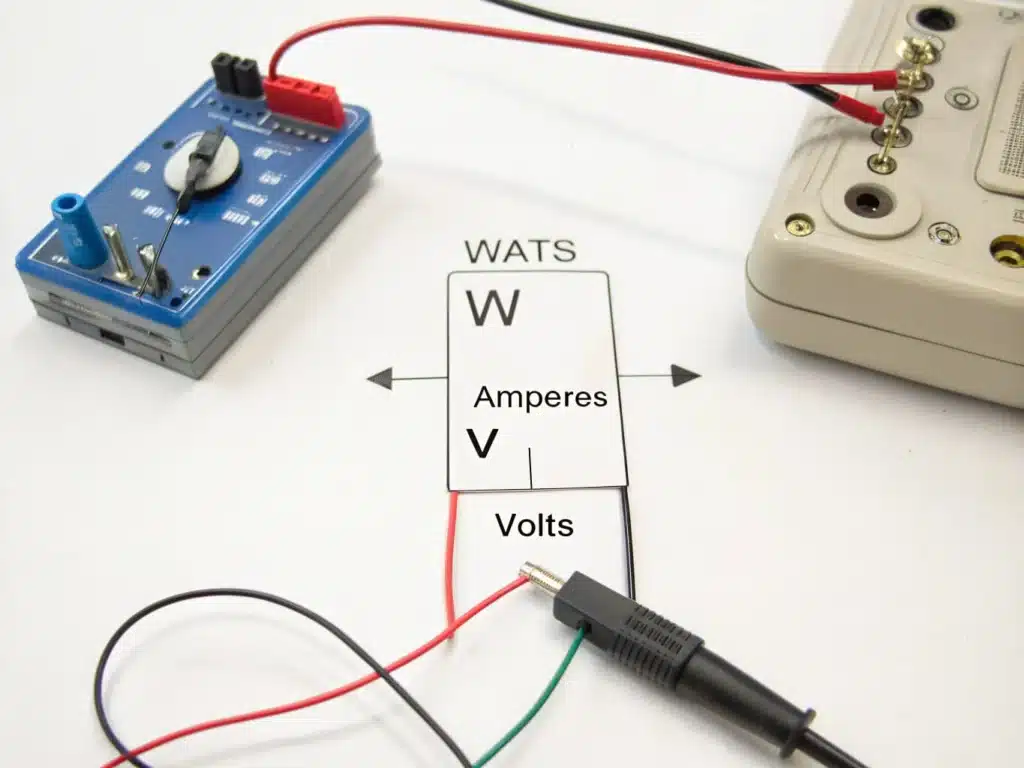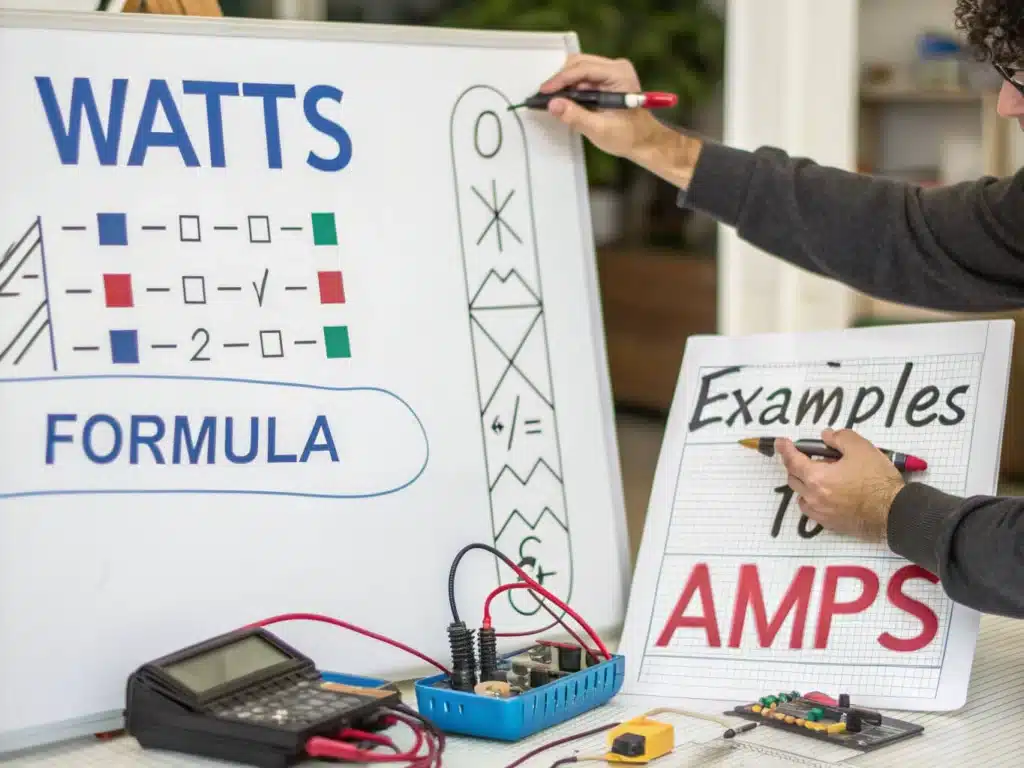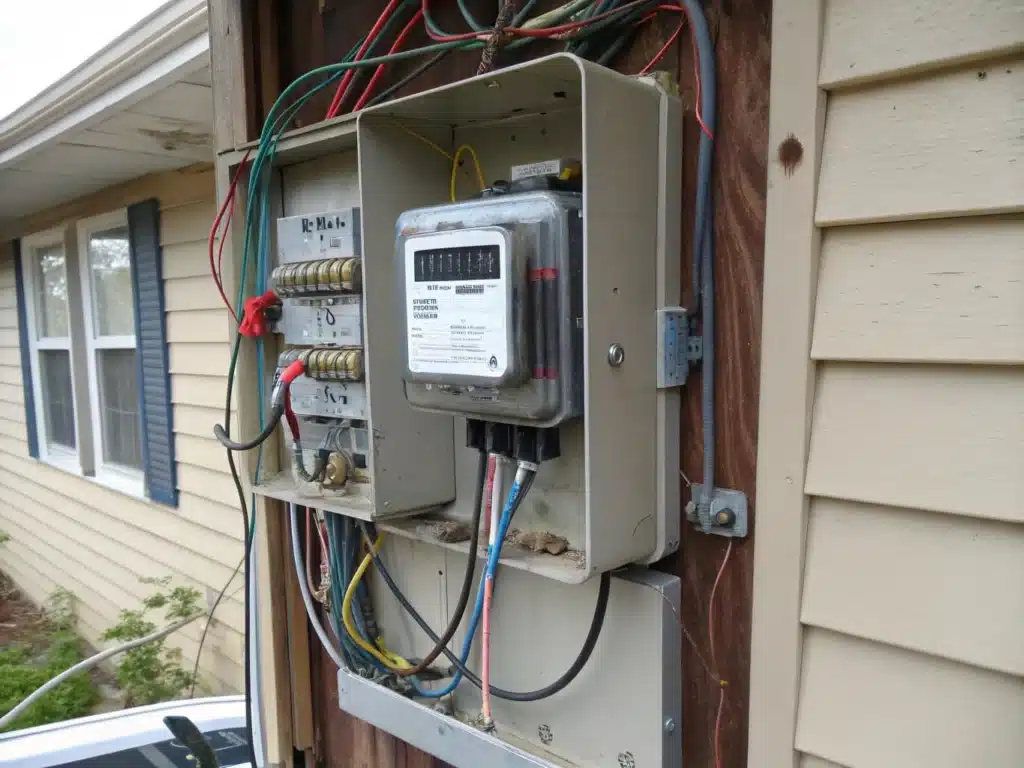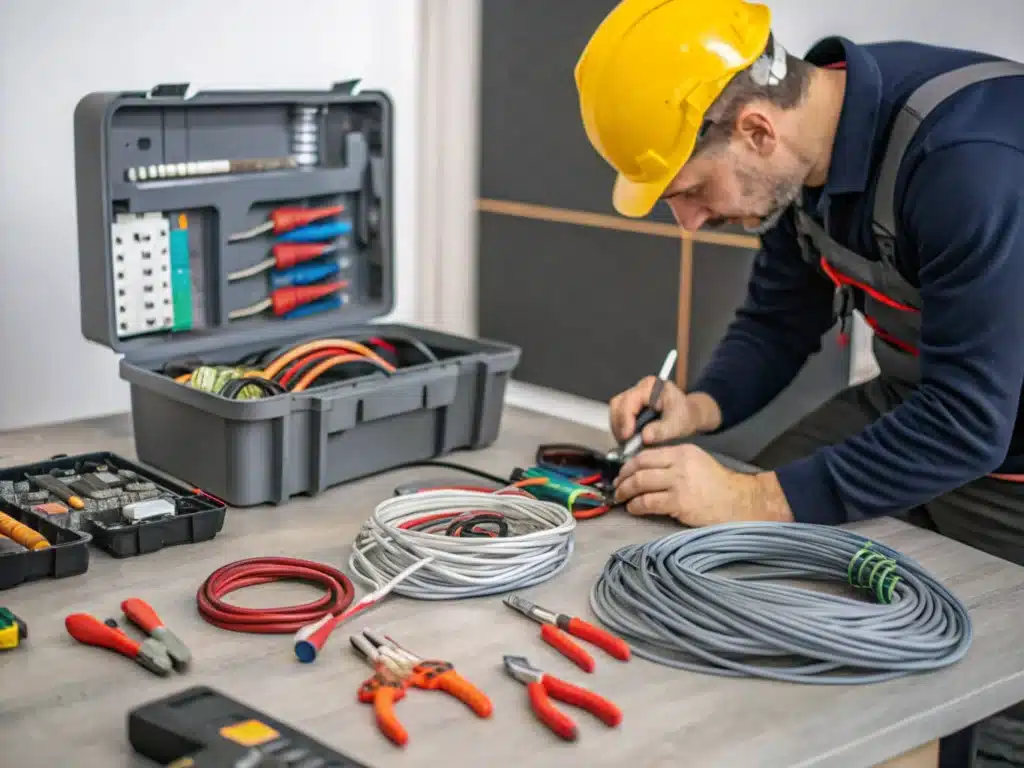When using electricity, buying electrical appliances, or doing DIY electronic projects, we often encounter power units, watts and amperes. Have you ever wondered whether a newly purchased high-power microwave or heater would trip the air switch at home? When configuring a power system for an RV or boat, how do you determine the size of the battery, inverter, or wire based on the total wattage of the appliances?
The key is to realize that watts (a measure of power, the rate at which energy is consumed or converted) and amperes (a measure of current, the rate at which charge flows) are two different physical quantities that cannot be directly equated. To accurately convert a device’s power into the current it produces in a specific circuit, we must introduce a crucial concept: voltage. This is because the actual current consumed by a device depends not only on its own power, but also on the voltage provided by the power system it is connected to.
Therefore, this article aims to provide you with a clear and systematic overview of the relationship between watts, amperes, and volts. We will explain these three basic electrical concepts in an easy-to-understand manner, reveal the core calculation formulas that relate to each other, and teach you step by step how to accurately convert watts to amperes in different voltage environments through real-life examples.
Table of Contents
ToggleWatt amp calculator
Amps to Watts
Watts to Amps
What are Watts, Amps, and Volts
In order to accurately understand and convert between watts and amperes, we first introduce the three most basic electrical concepts: power (watts), current (amperes), and voltage (volts).

Watt is the basic unit of power in the International System of Units. It measures the rate at which energy is consumed or converted, that is, the work done or the energy converted per unit time. In life, the “60W” or “100W” marked on a light bulb directly reflects its brightness and power consumption rate.
Definition: It is the basic unit of electric current in the International System of Units. It measures the amount of charge passing through a certain cross section of a conductor per unit time, reflecting the strength of the current. Circuit breakers (air switches) in homes often have specifications such as “10A”, “16A”, and “20A”, which represent the maximum current that the line can safely carry.
The household power supply voltage in different countries and regions is different. 220V is commonly used in mainland China, 110V-120V is commonly used in the United States and Japan; the standard voltage of car batteries is usually 12V; the charging voltage of the USB interface we commonly use is generally 5V.
The relationship between watts, amperes, and volts
We will now explore the precise mathematical relationship between them. This relationship is defined by a basic electrical formula and is the basis for unit conversion.
Power (P) = Voltage (V) × Current (I). The power consumed or generated by a device is equal to the product of the voltage applied across the device and the current flowing through it.
Similarly, when the rated power of an electrical appliance and its operating voltage are known, current = power (P) ÷ voltage (V).
How to convert watts to amps
Once you have mastered the above formula, ampere = watt/volt, you can perform the correct conversion in actual operation.

Step 1: Determine the power of your device
You need to find the power rating of the device you are interested in, which is in watts (W). It is usually on the back, bottom or nameplate, such as 1200W.
Step 2: Confirm the power supply voltage
You must specify the voltage of the power system to which the device will be connected, in volts (V). For example, 220V is common in mainland China, while 110V or 120V is common in North America. Be sure to use the actual local voltage. Small vehicles are usually 12V direct current (DC), while large trucks or special vehicles may be 24V DC.
Step 3: Apply the formula to calculate
Now that we have the two key values of the device power (Watts, from step one) and the power supply voltage (Volts, from step two), we plug them into the conversion formula we highlighted earlier:
Current (Amperes) = Power (Watts) ÷ Voltage (Volts)
Suppose you have a hair dryer with a power rating of 1200W on its nameplate and plug it into a household wall socket in mainland China with a voltage of 220V. Then the current = 1200W ÷ 220V ≈ 5.45A.
Watts into amps converter
Below is a table of various watts to amps conversions, sorted from smallest to largest, assuming the voltage is 120V.
| Watt (W) | Voltage(V) | Ampere (A) | Watt (W) | Voltage(V) | Ampere (A) |
| 5 | 120 | 0.04 | 10 | 120 | 0.08 |
| 12 | 120 | 0.1 | 15 | 120 | 0.13 |
| 18 | 120 | 0.15 | 20 | 120 | 0.17 |
| 24 | 120 | 0.2 | 25 | 120 | 0.21 |
| 30 | 120 | 0.25 | 40 | 120 | 0.33 |
| 45 | 120 | 0.38 | 50 | 120 | 0.42 |
| 60 | 120 | 0.5 | 65 | 120 | 0.54 |
| 80 | 120 | 0.67 | 90 | 120 | 0.75 |
| 100 | 120 | 0.83 | 120 | 120 | 1 |
| 150 | 120 | 1.25 | 175 | 120 | 1.46 |
| 180 | 120 | 1.5 | 200 | 120 | 1.67 |
| 240 | 120 | 2 | 250 | 120 | 2.08 |
Conversion examples in different scenarios
The following will use several typical scenarios to show how to use the Amperes = Watts / Volts formula to solve practical problems and reveal the significant impact of voltage changes on current demand.

A coffee machine with a rated power of 880W, working under China’s 220V mains, requires the following current: Current = 880W / 220V = 4A. Assuming a kitchen circuit protected by a 16A circuit breaker, you also use a 2200W electric kettle (2200W / 220V = 10A) and a 1100W microwave oven (1100W / 220V = 5A). Total current = 10A + 5A = 15A. This value does not exceed 16A and is theoretically safe.
Scenario 2: In automotive, RV or marine environments, ensure the power safety and component selection of the 12V DC system.
For example, for a 60W car refrigerator, in a 12V system, the current is: Current = 60W / 12V = 5A.
Scenario 3: Low-voltage DC and USB devices, understanding the power requirements of small devices and charger/power supply compatibility.
When a mobile phone is fast charged, if the charging power is 18W, at a voltage of 5V, the current is: Current = 18W / 5V = 3.6A. Knowing the current required by the device will help you determine whether the output port of the USB charger or mobile power supply used can meet its needs.
Typical power factor values
The following table shows typical power factors, with the maximum factor being 1.
| Device | Typical power factor |
| Resistive load | 1 |
| Fluorescent lamp | 0.95 |
| Incandescent lamp | 1 |
| Induction motor fully loaded | 0.85 |
| Induction motor no-load | 0.35 |
| Resistance furnace | 1 |
| Synchronous motor | 0.9 |
Why is this conversion important
Understanding and being able to perform the conversion from Watts to Amps has extremely important practical applications in everyday electricity use and professional electrical work.
Ensure electricity safety
Prevent circuit overloads: Wires and circuits are designed to carry a maximum current. When the total power of the connected appliances is too high, the rated ampere of the circuit may be exceeded. Excessive current will cause the wires to heat up rapidly, which may melt the insulation, cause a short circuit or even a fire. This can help you predict potential overload risks and avoid using too many high-power devices at the same time.
Choose the right protective device: The air switch and fuse of the circuit in the home are used to cut off the circuit when the current exceeds the preset safety value. Knowing the actual working current of the electrical appliance is the basis for choosing the circuit breaker or fuse with the correct rated ampere, ensuring that they can act promptly and reliably when danger occurs, rather than tripping or failing by mistake.
Guide the selection of equipment and wires

Choose wires with the right diameter: The thickness of the wire determines its safe current carrying capacity. Thin wires have a large resistance and cannot safely carry large currents. When wiring high-power equipment (such as air conditioners and electric heaters), first calculate its operating current, and then choose wires with a diameter thick enough to withstand the current. Otherwise, the wires will overheat, the voltage will drop significantly (affecting the performance of the equipment), or even burn out.
Choose the right generator, UPS, and inverter capacity: Whether you are buying an emergency generator or installing an inverter on an RV or ship that converts battery DC power into AC power, you need to evaluate the total load it needs to drive. By calculating the total current when all devices are working at the same time, combined with the voltage, you can convert the total power required, so that you can choose a power supply device with sufficient capacity to ensure that it will not fail to start or frequently shut down due to overload.
Support electrical system planning and design
When designing complex electrical systems, such as planning the power supply network for residential and commercial buildings, designing off-grid or grid-connected solar photovoltaic systems, etc., accurately calculating the current requirements of each branch circuit and the entire system is the absolute basis for all subsequent work (such as determining the main line specifications, battery capacity, solar panel array size, controller and inverter specifications, protection device configuration, etc.). Without accurate current data, the safety, reliability and economy of the entire system are out of the question.
Common misconceptions
When converting and applying Watts to Amps, you need to pay special attention to the following common misunderstandings.
- Assuming that Watts can be directly converted to Amps, ignoring the voltage factor. One of the most common and basic mistakes is to assume that there is a direct, fixed conversion relationship between power (Watts) and current (Amps), while ignoring the decisive role of voltage (Volts). When applying the formula, it is important to confirm that the voltage value substituted is the actual system voltage.
- Consider the impact of starting current on specific types of equipment. Many devices containing electric motors, such as air conditioners, refrigerators, water pumps, compressors, and some power tools, will generate a surge current much higher than their normal operating current at the moment of starting. This short but significantly increased starting current (which may reach 3 to 8 times the rated current or even higher) is a common cause of circuit breaker tripping or fuse blowing, so it is also necessary to pay great attention to possible starting current shocks.
- How to find the wattage of an appliance and the voltage of your system. The most direct way is to look at the appliance itself. Almost all compliant appliances will have a nameplate or specification label attached to the body. The label will clearly indicate the rated power and operating voltage range of the device.
Summary
A deep understanding and accurate application of this conversion formula, Ampere = Watt / Volt, is of vital practical value for ensuring daily electricity safety, avoiding circuit overload, and rationally selecting electrical equipment and cable specifications. It is recommended that you try to calculate the current values of commonly used electrical appliances around you to deepen your understanding and practice.
FAQs
To calculate the current requirements of household appliances, refer to the formula Amps = Watts / Volts.
If the power of the appliance is 2000W and the domestic voltage is 220V, I = 2000 / 220 = 9.09A.
Power factor (PF) is the ratio of active power to apparent power, reflecting the conversion efficiency of the power system. The closer the power factor is to 1, the higher the efficiency of electric energy utilization.
Different types of loads such as inductive or capacitive loads also affect the power factor.
The power factor not only affects the current calculation, but is also directly related to the efficiency, cost and stability of the power system.
